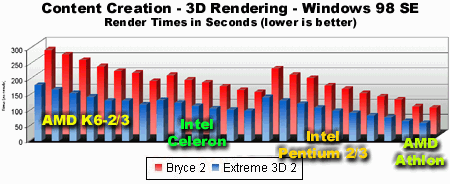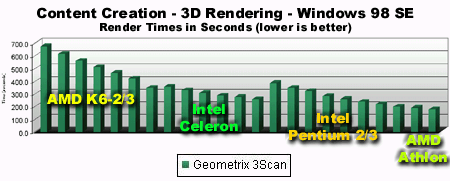Desktop CPU Comparison - September 99
by Anand Lal Shimpi on September 6, 1999 1:23 AM EST- Posted in
- CPUs

3D rendering applications are do or die for most CPUs these days, they either perform or they don't. 3D rendering applications are heavily dependent on FPU performance as well as L2 cache/memory performance, the two benchmarks illustrated here were taken from the SYSmark 98 suite so there are no individual SSE or 3DNow! optimizations included.
In both cases the Athlon takes a very healthy lead over the competition with a 20 - 25% lead under Bryce 2 and a 15 - 25% lead under Extreme 3D 2, there is no questioning the fact that the Athlon does have a very strong FPU.
The Celeron, although being outperformed by the Pentium III on a clock for clock basis, still stands strong and truly isn't that much slower than its bigger more expensive brothers. The true test of how useful the Celeron would be under a high-end environment comes under the Windows NT 4 tests which we'll get in to a little later.
The weak FPU of the K6-X processor line keeps them at the dead end of the performance spectrum, even the K6-III falls short in spite of its on-die L2 cache. For anything FPU intensive, the K6-2/3 isn't your best performing choice.
The modeling and animation done in the Extreme 3D 2 test takes much longer to complete and thus gives us a more exaggerated picture of how the processors compare to each other. The results are still virtually identical to the Bryce 2 tests in terms of the performance standings of all of the processors.

The AMD supplied Geometrix 3Scan benchmark makes no effort to hide the K6-2's weak performance, with the Athlon taking a subtle lead over the fastest Pentium IIIs. Once again, the Celeron comes in a tad slower than the Pentium III however the issue of price to performance ratio is often times the definitive factor when purchasing a CPU in which case the Celeron normally wins.
The K6-III's on-die L2 cache does help out somewhat, however at 450MHz it still has difficulty competing with even the Celeron 366, the bottom line seems to be (something we've always known) that the K6-X line of processors simply aren't suited for high-end 3D rendering work. At the same time, the Celeron is a slower but cheaper alternative to the Pentium II/III and now the Athlon, both of which excel at 3D rendering applications due to their powerful FPUs and larger L2 caches.










0 Comments
View All Comments